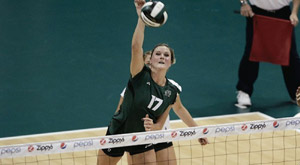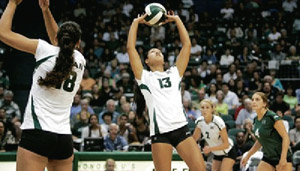Big West Drags Down UH Wahine
A tough draw is an under-statement.The University of Hawaii Rainbow Wahine volleyball team put together a 25-2 regular season record, which was good enough for a No. 8 ranking in the final NCAA coaches poll. It wasn’t quite as high as the No. 3 ranking it finished with a year ago, but this was a strong and versatile team – as has come to be not just expected, but taken for granted under Dave Shoji – that put together an undefeated Big West season and hadn’t lost since early September.
Their reward for such a season? Being unseeded in the NCAA tournament and set up to take on some of the top teams in their own backyards.
With 16 teams in the 64-team tournament being seeded and the rest filled in as visitors, it stands to reason that, unless there had been a gross miscalculation of talent, the eighth-ranked team should benefit from one of those top 16 spots. Yet UH was not only unseeded, but placed on a collision course with teams having to do very little travel.
The tournament committee seemed to pay much more attention to the final RPI rankings, which incorporate a team’s strength of schedule, in its seeding. Hawaii was ranked 17th in the RPI, with the team’s move to the Big West from the WAC seemingly a detriment to its power ranking.
But you can only play who is put in front of you, and the Wahine’s NCAA tournament path still did not seem indicative of their accomplishments.
It started with a first-round matchup in Seattle against Santa Clara, where the Wahine took care of business in a 3-0 victory. All right, nothing out of the ordinary, although Santa Clara had to fly only about an hour and a half to arrive. But keeping travel costs down is understandable, even if it means having an unranked team closer to the tournament site than a top program.It was the second round that closed the book on the Wahine season, as they faced the University of Washington. The Huskies finished the season ranked No. 5 in the country. So in the second round, with 32 teams still alive, a pair of top-eight teams were facing off, one of them in front of its home crowd. This was a regional final matchup taking place in the round of 32.
As expected, the two teams went back and forth in a hotly contested match, ultimately won in five sets by the Huskies (20-25, 25-20, 19-25, 27-25, 15-11).
Again, the committee seemed to lay more credence to the RPI rankings in its decisions, since Washington (No. 5 coaches poll, No. 16 RPI) seemed under-seeded at No. 13.
Even if UH had managed to break through and pull out the win, it would have then had to travel to Omaha to take on the University of Nebraska (No. 10 coaches poll, No. 5 RPI) in the round of 16. Nebraska received the No. 4 overall seed in the tournament.
So after a 25-2 season, UH drew a pair of top-10 teams in the first three rounds, each playing in front of its home fans.
I understand that it’s difficult to bring multiple teams out to play at Stan Sheriff Center when UH is the only local team. It’s much easier to send the Wahine to the Mainland.
And maybe we got a little spoiled by hosting the first two rounds last year, the first NCAA games played out here since 2006.
But it seems as if the Wahine, who are already behind the eight ball when it comes to the NCAA tournament because of their location, have seen their regular season deemed completely meaningless with the move to the Big West.
There was already a perception that, despite the impressive records every year, they can’t really compete with the top teams. Now that perception will be even tougher to shake.
The only way to change that perception is to go out and beat these top programs in the tournament each year, but that is made much more difficult when they are essentially road matches.
The answer may be scheduling more top teams during the regular season, because without marquee wins, the RPI will continue to be cruel to the Wahine.





